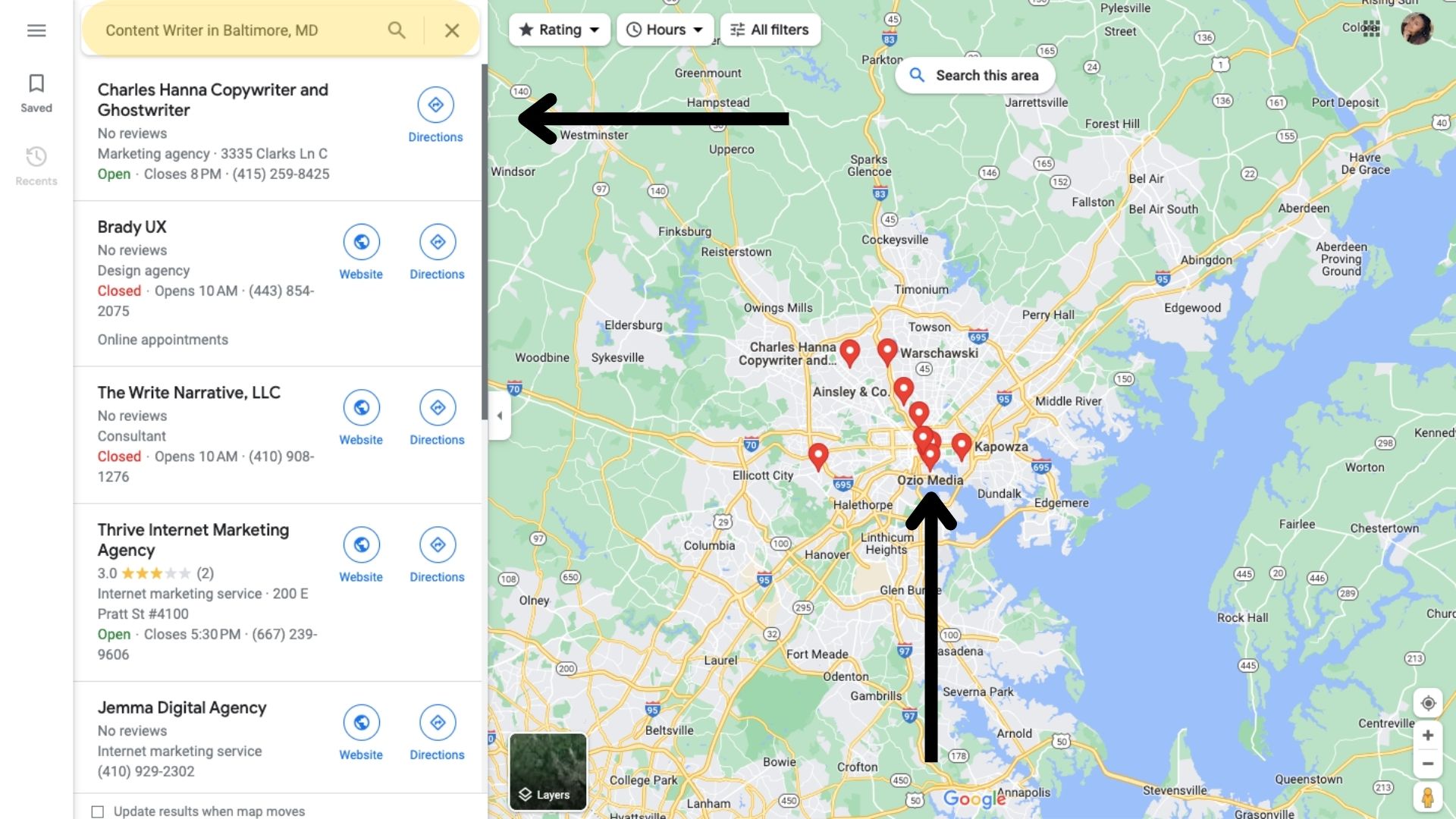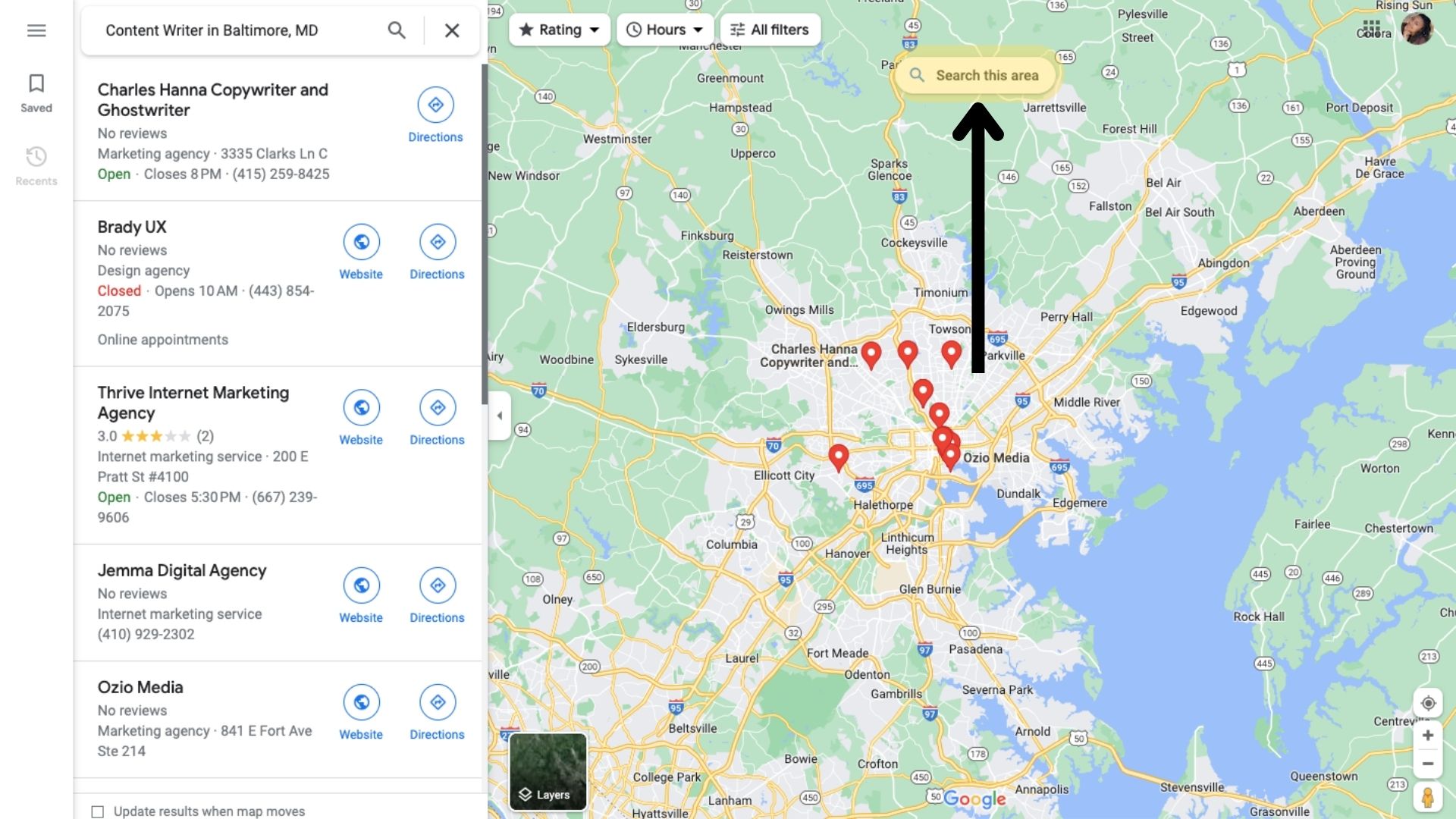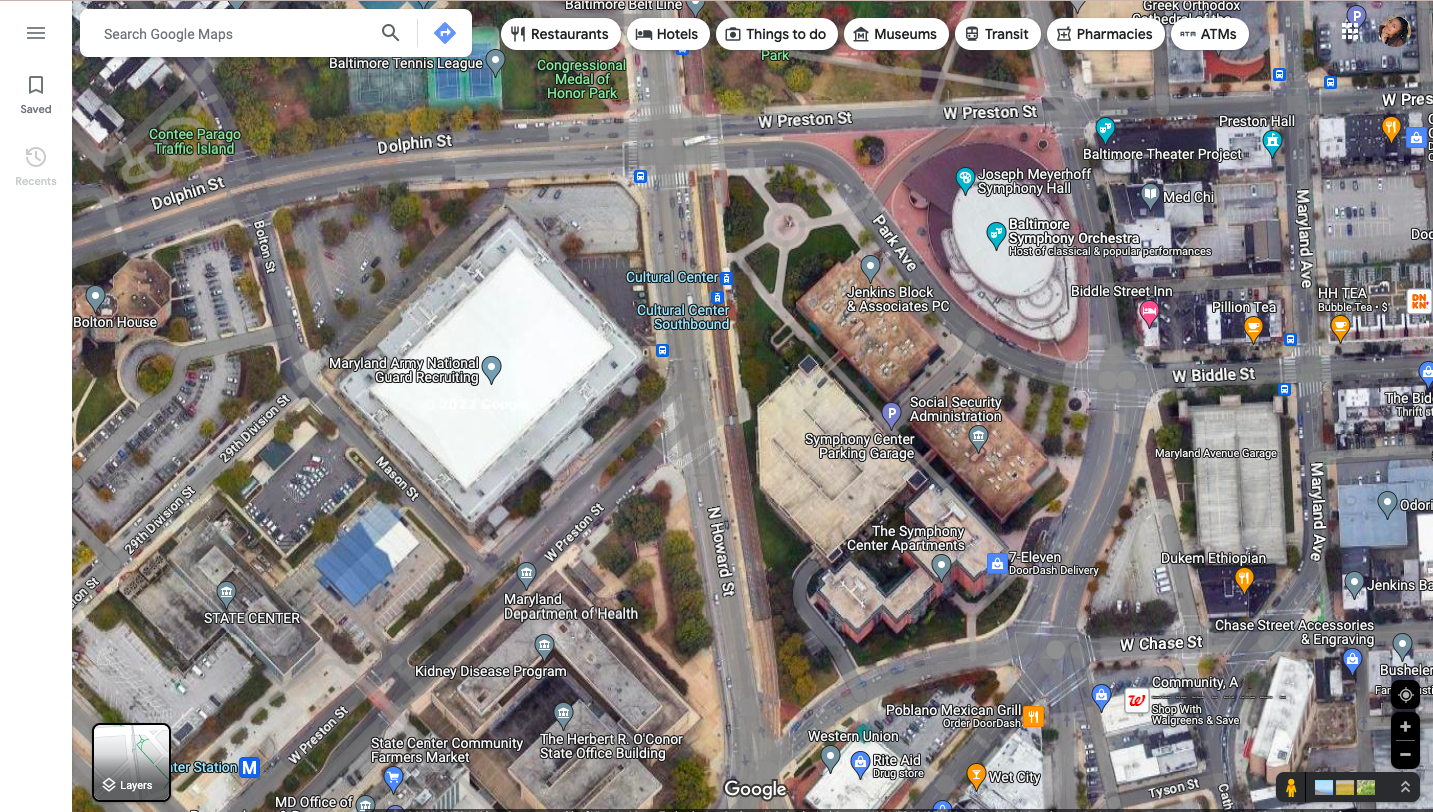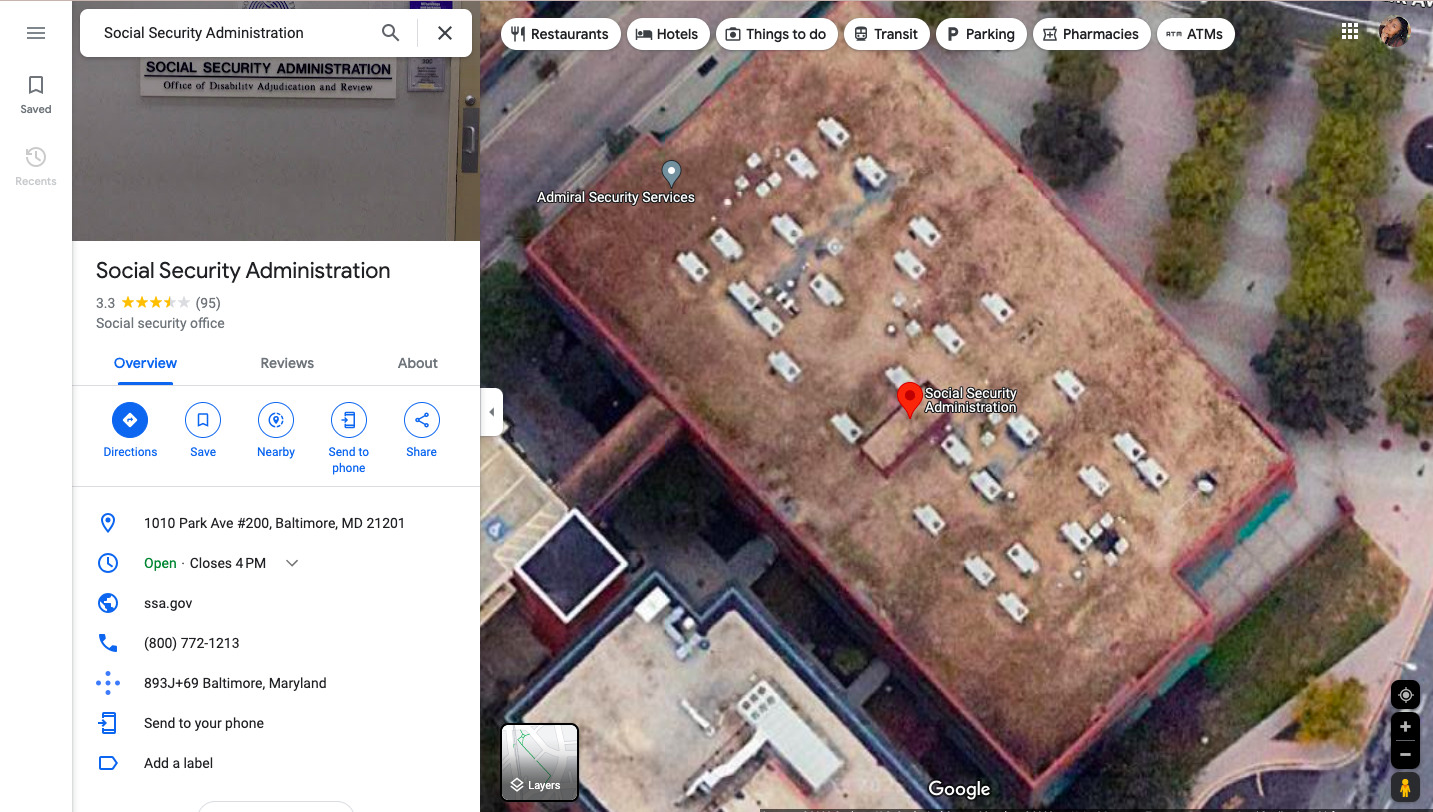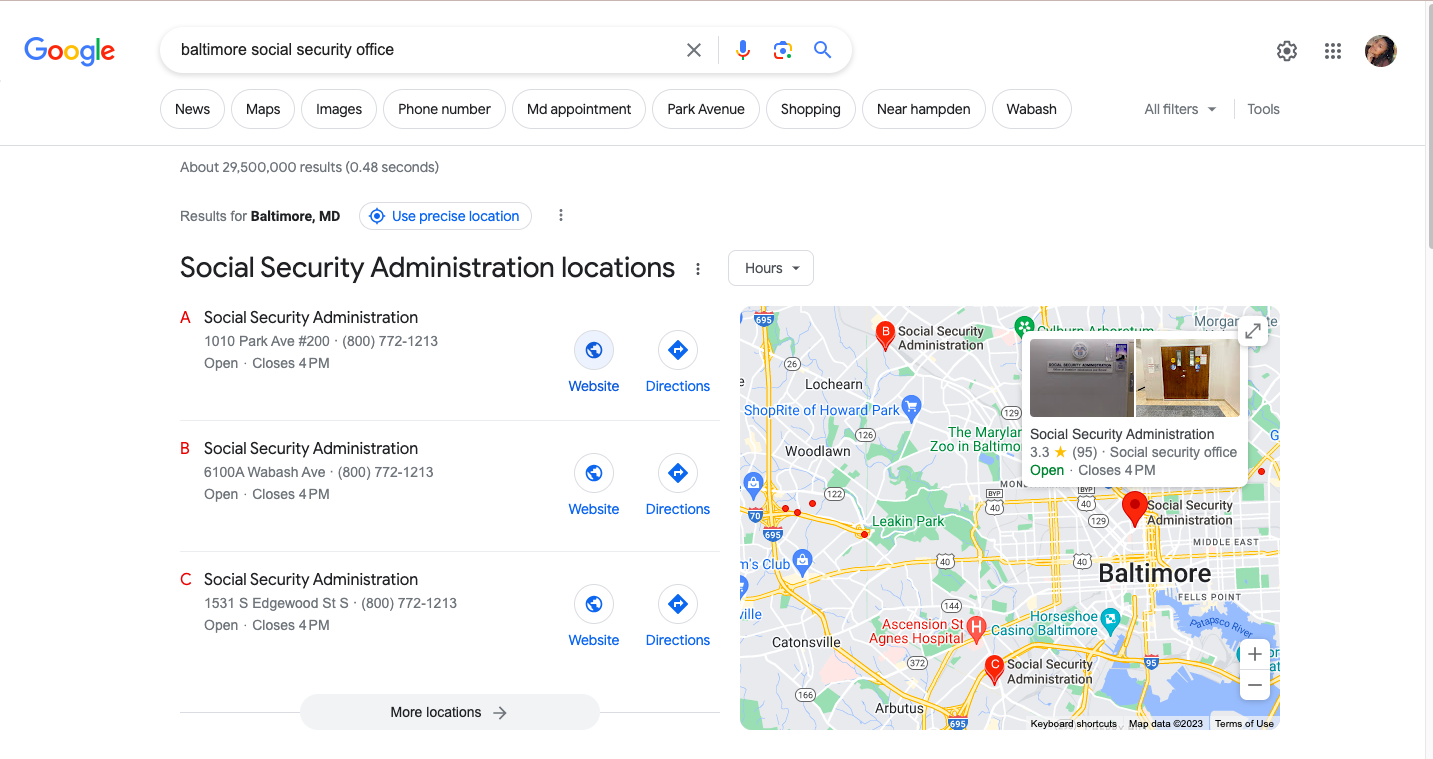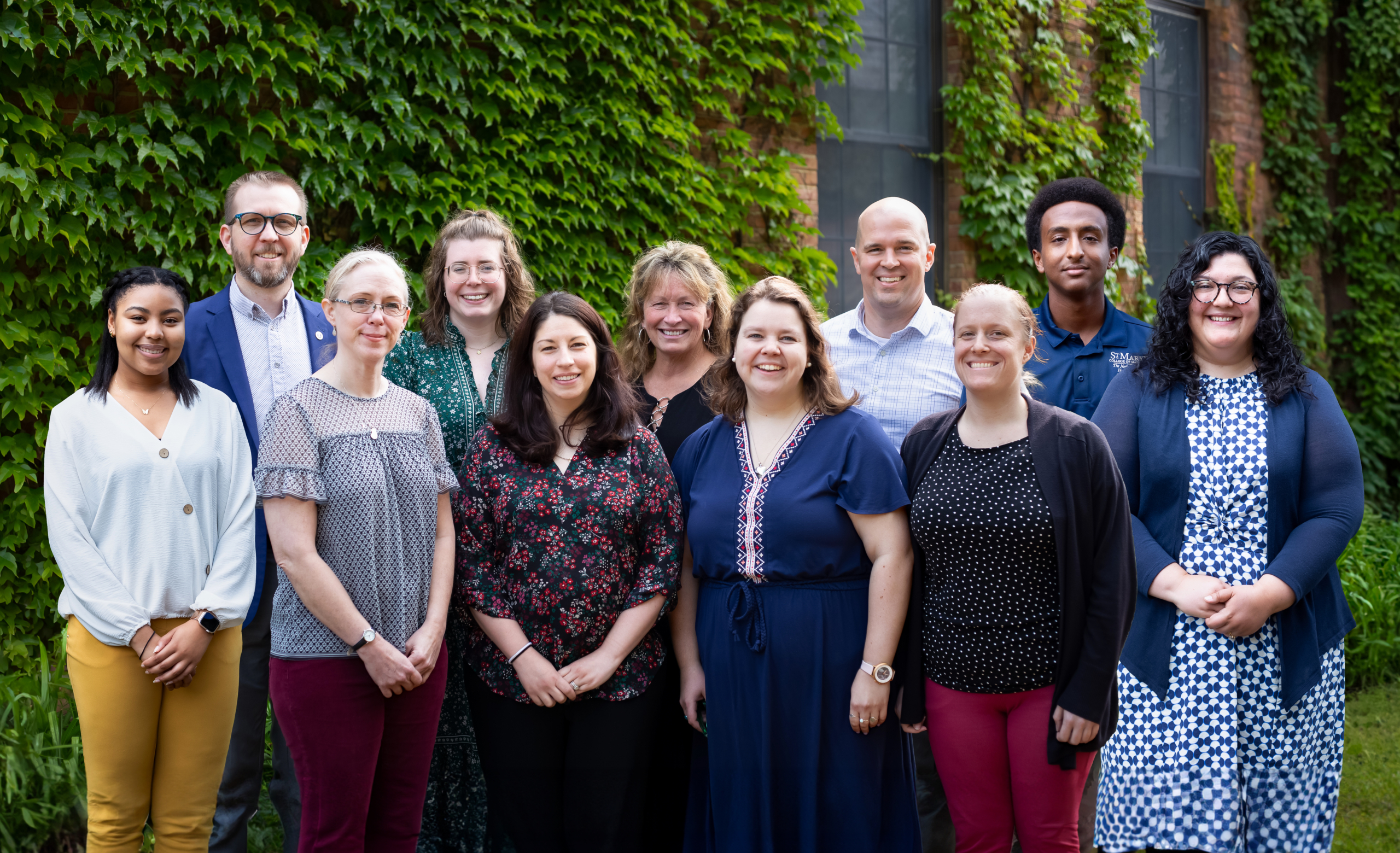BUILD CONNECTIONS
Although it is important to have a professional resume and a presence on LinkedIn and Handshake, connecting with people is the most important factor in securing a job. People hire people, so always remember to put your best foot forward when building new connections. You never know who might be able to connect you with your dream job!
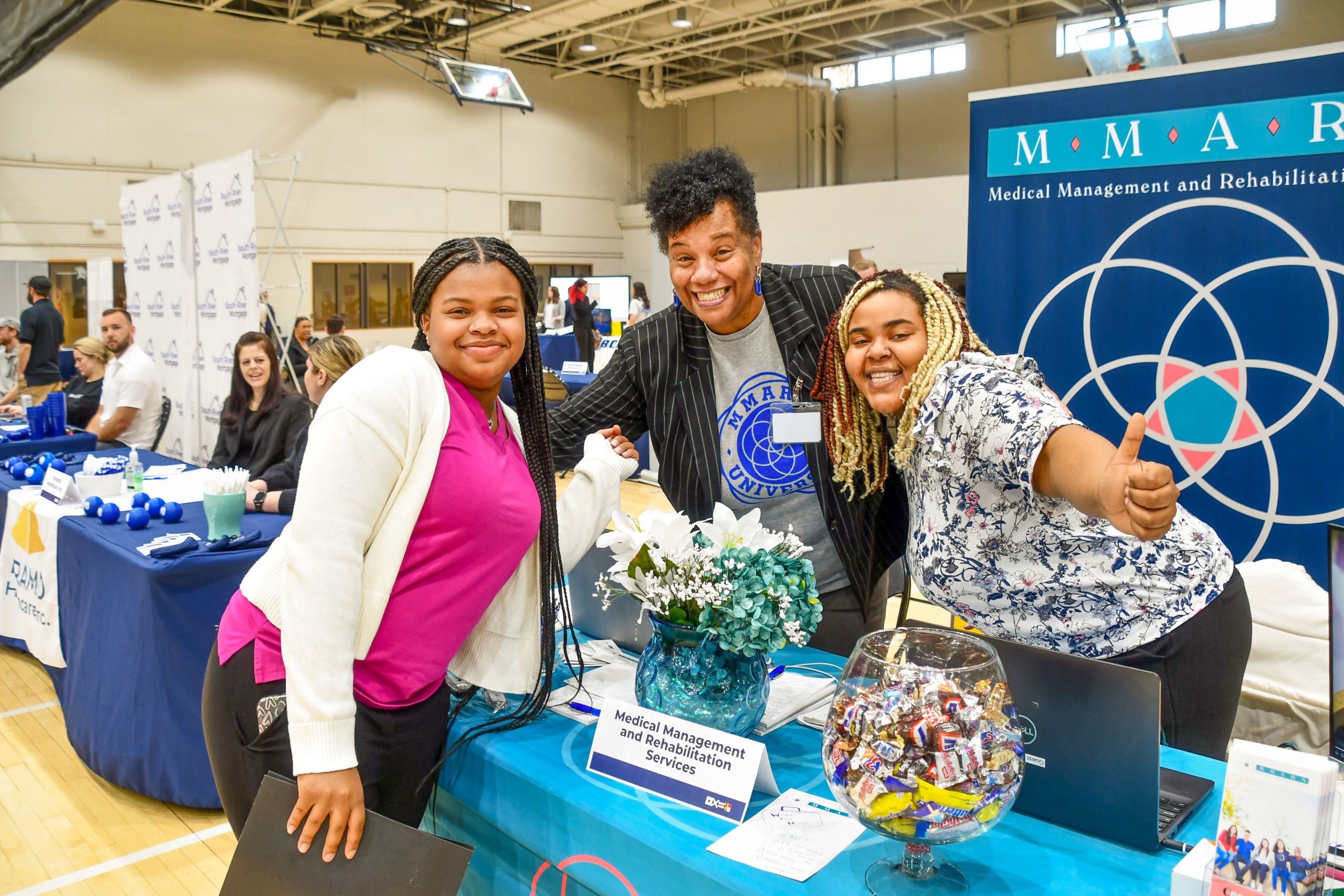

RESEARCH THE ORGANIZATION'S CULTURE
Company culture is the personality of the company. An organization’s culture includes the values and beliefs that are important to people in that organization. Components that influence and impact an organization’s culture include:
Relationships
- Organizational structure
- Effective leadership
- Co-worker relationships
- Organizational trust
- Celebrations
Communication
- Feedback
- Input
Job satisfaction
- Meaningful work
- Employee engagement
Benefits (see How to Negotiate Salary and Benefits for more information)
- Work-life balance
- Pay and bonuses
- Leave policy
- Insurance
- Recognition
Opportunities
- Opportunities for collaboration
- Growth & development
- Empowerment
- Promotions
Spending time on the organization’s website, reading news about them, following their social media pages, and even looking at customer reviews can help you gain insight about their culture. How the organization responds in the public eye can tell you a lot about their culture.
You could also schedule an informational interview with someone who works in the industry to learn more about their organization’s culture. For more information on informational interviews, see the section on informational interviews.
You can use employee review sites to learn more about an organization’s work environment. Glassdoor, Indeed, Comparably and CareerBliss are all free company review sites—and so is Handshake! Don’t worry if you find a few negative reviews—and don’t assume the organization is great based on a few positive reviews. Instead, be on the lookout for repeated themes of satisfaction or dissatisfaction.
To learn more about an organization in Handshake, follow these three easy steps:
1. Click on the EMPLOYERS tab on the left-hand side of the screen.
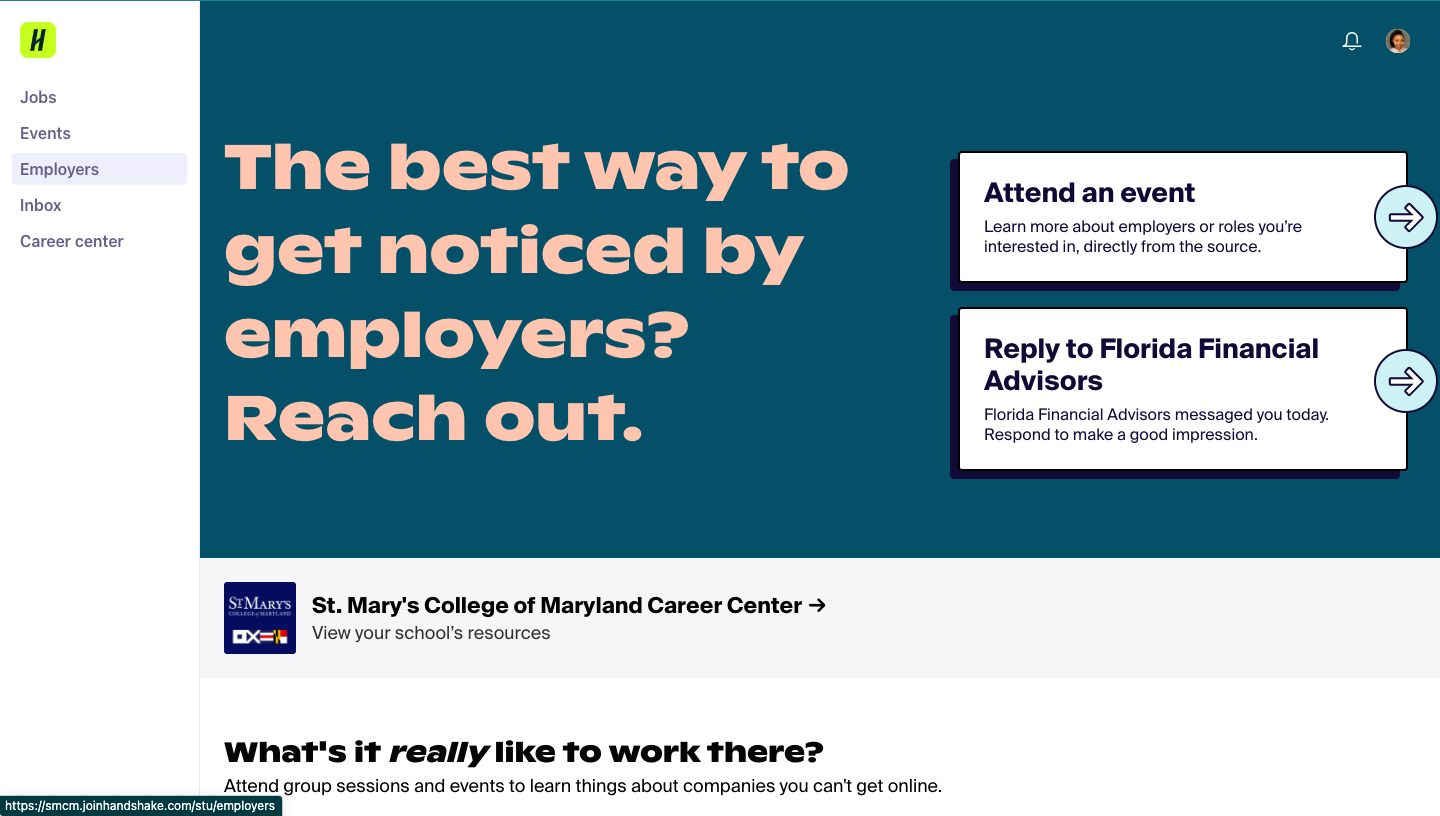
2. In the SEARCH bar, type in the organization you would like to learn more about.
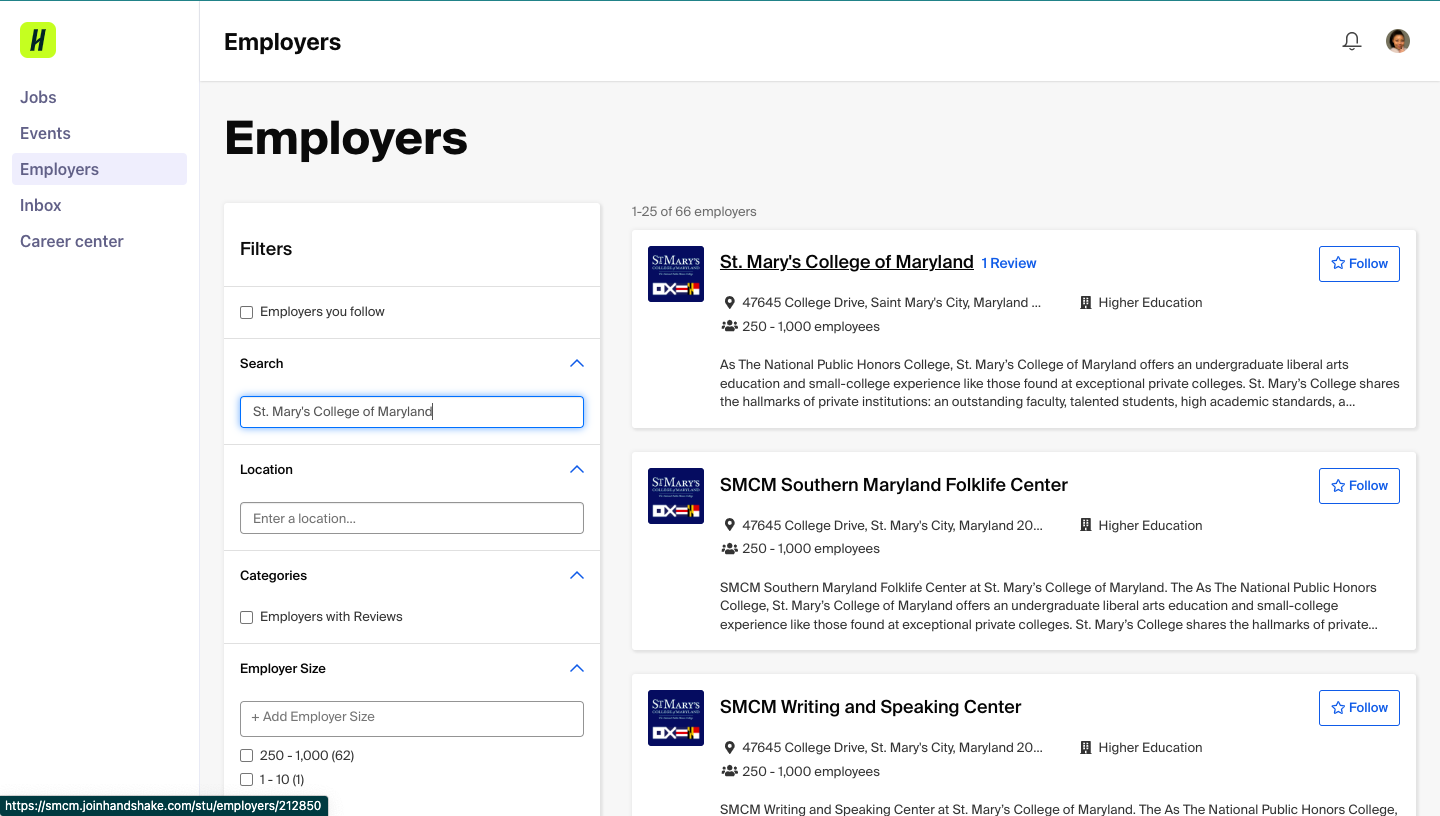
3. Click on the REVIEWS tab to see reviews of the organization.
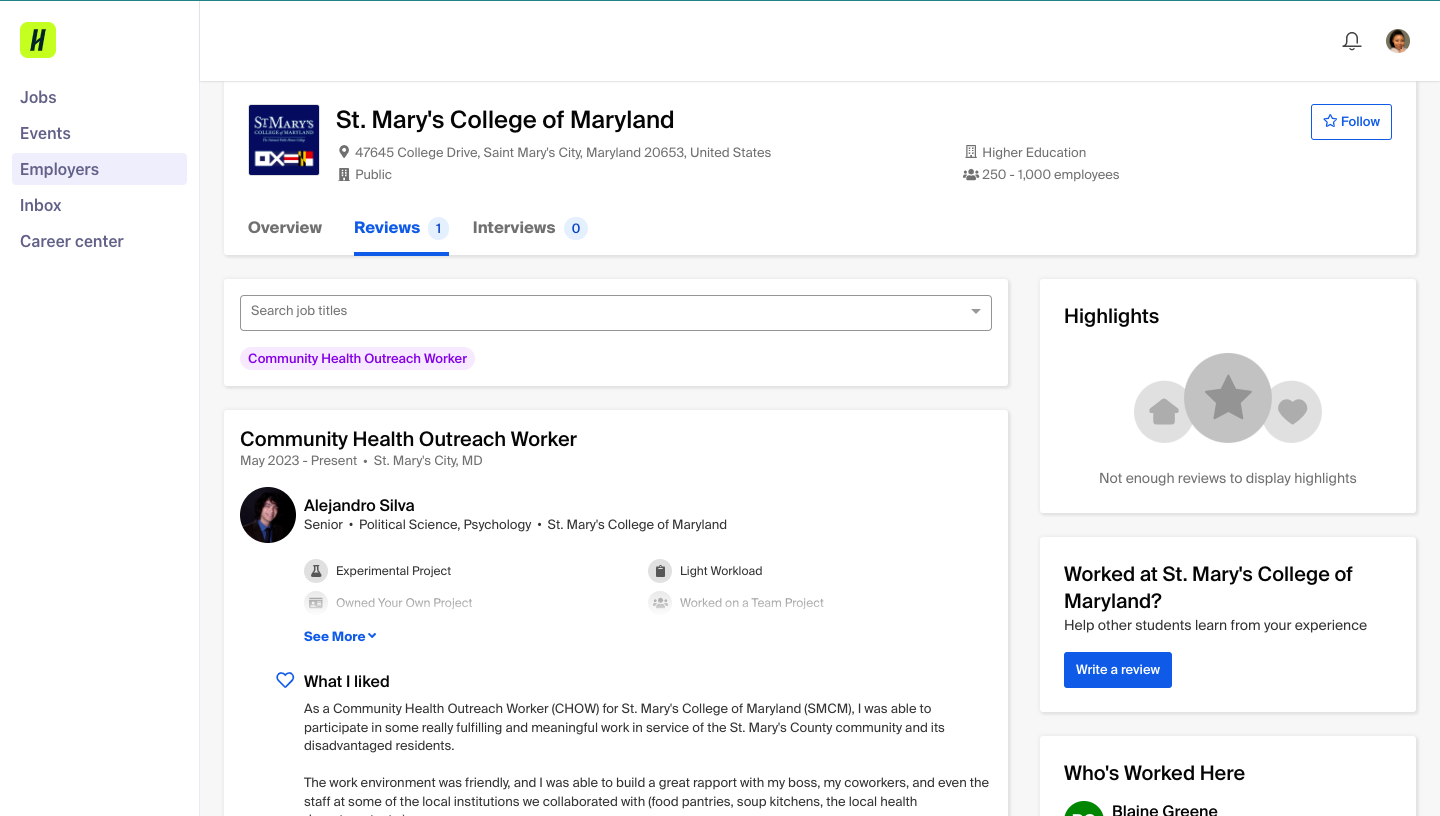
JOB BOARDS
Handshake
Handshake is the number one way college students get hired. It is an online recruiting platform that allows students to connect with employers, discover jobs and internships, and find career fairs and employer events. To begin using Handshake, go to smcm.joinhandshake.com and log in using your SMCM email and password, or scan the QR code below to download the app.
To get the most out of your Handshake profile, add relevant and important details about you and your career interests. A completed profile shows a full picture of you as a student/alum and professional. A completed profile includes your skills, work experience, graduation date, organizations you participate in, and career interests. 80% of students who share their interests receive a message from a recruiter on Handshake.
Additionally, you should upload your resume and use a professional photo for your profile picture.
Pro tips:
- If you start by uploading your resume, Handshake will use the information to auto-fill your profile!
- Handshake and LinkedIn profiles are very similar, so you can save time if you copy and paste the information between the two.
Need more info? See Getting Started with Handshake, stop by the Center for Career & Professional Development at Glendenning Hall 210, email us at careercenter@smcm.edu, or call us at (240)-895-4203.
USAJobs
USAJobs is the central U.S. Government job posting platform that allows you to find and apply for federal jobs at U.S. government agencies around the world.
Create a USAJobs account and profile to access their wide variety of jobs. Your profile will help you customize and streamline your federal job search. You can also set USAJobs to send you notifications about jobs you may be interested in. To create an account, click here.
To perform a job search, think of specific keywords that highlight your professional interests. Your search criteria will be displayed on the left side of the page. If you like any of the suggested results, you can save them by starring them and apply for them later.
For more information on beginning your job search and preparing your application, visit the USAJobs Help Center article How does the application process work?
Indeed
Indeed is a popular job search website. The platform hosts thousands of job postings, with options for refining your search by salary, industry, job title, experience level, and more! You can also turn on notifications to be updated when new jobs are posted. Indeed also has a wide selection of articles on career advice/development, interview preparation, job searching, and much more. To browse the full list of Indeed’s articles, click here.
Here are six steps to get you started with Indeed.
- Create a free Indeed account. Creating a Indeed account gives you access to a variety of job postings. After creating your account, you can save jobs you’ve found that you want to apply to later. Your saved jobs will appear on your My Jobs page. Once you’ve submitted an application, you’ll be able to track your application status under the My Jobs page. You also have the option to upload your resume for employers to review.
- Browse positions by location in the search menu. Use the search bar and keywords related to your industry to begin your search. Use the “where” box to specify locations or regions you would prefer to work. You can search broadly by city or state or narrow your search by typing in a zip code. Filter results based on your requirements.
- Filter your results. If you know the qualifications and requirements of a particular job or industry, you can use Indeed’s filtering tool in the search bar or under the options bar to refine your search. You can filter your results based on job type, distance, salary, location, employer, and experience level.
- Set up job alerts to stay up to date. Setting up job alerts is a great way to stay updated on new job opportunities. Job alerts are email updates about new job postings that match the criteria you’re interested in. You can set up job alerts to notify you daily or weekly.
- Research employers to learn more. If you find an employer or job posting that interests you, you can click on their employer website to learn more about who they are. Researching the organization you are interested in is a great way to ensure the employer is for you. You can set up an informational interview to learn more about the employer if you have additional questions. For more information on informational interviews, see the section on informational interviews.
- Explore average salaries by employer and job title. Knowing your wages and average salary can help you decide if an employer is a good fit for you. Reviewing this information can help you set your compensation expectations at an appropriate level in relation to your experience level. You can find average salaries by employer and job title on Indeed Salaries.
When deciding on a job, remember to consider more than just the salary. Benefits such as time off, retirement pay, bonuses, and health insurance could actually make a lower-paying job better than a higher-paying one.
EMPLOYER WEBSITES
Employer websites are a great place to start if you want to learn whether the employer could be a good fit for you.
If you are interested in a specific employer, going directly to their website is a great job search method. On many employer sites you can find and apply for a variety of positions, from part-time to management positions. Jobs are typically listed under one of the following sections: Careers, Jobs, Human Resources, or About Us.
LinkedIn is a business and employment focused social networking site that allows you to connect with friends, family, professors, employers, and alumni as professional contacts. You can use LinkedIn to find jobs and internships, build connections, and further professional relationships.
There are two main purposes for LinkedIn:
- Advertise yourself. Your LinkedIn profile serves as your public resume and professional portfolio. (Note that you can also copy and paste between LinkedIn and your Handshake profile.)
- Connect with people for advice and help in your career exploration and job search.
Creating a LinkedIn profile can help you access job opportunities by showcasing your unique professional goals, aspirations, and journey through experience, skills, and education. Click here to learn more about creating a free account to get started. To make the most of your profile, use the Quick Reference Guide to ensure all required sections are completed.
LinkedIn also has a job search tool to help you find relevant opportunities that match your skills and qualifications. You can search for a job using the search field at the top of the LinkedIn page, or you can directly access the Jobs page here.
The SMCM Alumni Tool is a great way to connect with students who have similar education or professional interests as you. Reaching out to a St. Mary’s College alumni for an informational interview is a great way to get advice about career options and learn more about industries you are interested in.
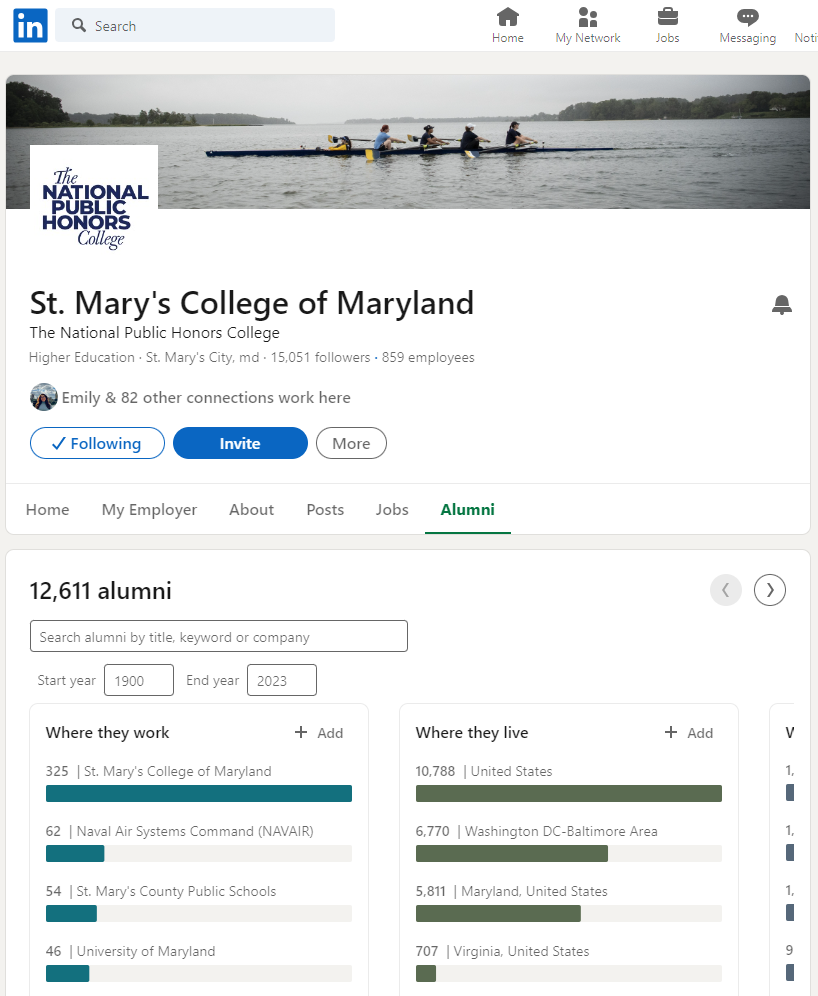
MICRO INTERNSHIPS
Micro internships are short-term, project based, professional assignments that provide you with the opportunity to develop skills in a specific industry, explore career options, and build connections. Micro internships can take place year-round and may range from 5 to 40 hours of work. Projects are typically due between one week to one month after your start date.
St. Mary’s College of Maryland micro internships are hosted through Parker Dewey and Forage.
Meet our Internship Coordinator, Taylor Flemming.
Taylor is enthusiastic about connecting students and employers for internship opportunities, and serves as the first point of contact for internship information. Contact her at internships@smcm.edu or schedule an appointment.

GOOGLE MAPS
It might surprise you to learn that Google Maps is a useful tool for job searching. It’s a great way to find jobs in your local area or in your desired location. Using Google Maps is also a good way to discover small, boutique employers that may not have jobs posted on job search platforms.
There are three strategies for searching for jobs with Google Maps:
Option 1:
- Go to the Google Maps search bar and type in relevant keywords related to your job search. Be sure to be specific with your keyword searches to see the most relevant employers.
- Your search results will be listed under the search bar and will appear on the map as little red pins. You can scroll through the map to view employers in different locations.
- If you don’t see any employers or pins, make sure to click the “search this area” button located at the top of the map. The map will refresh automatically to show you jobs in that area. You may then choose jobs to apply for. For more tips, see Leveraging Google Maps to Job Search.
Option 2:
- Zoom into a location and look at employers in the surrounding area. You can do this with or without the satellite view turned on.
- Click on employers you are interested in learning more about. You can click on their websites to learn more about them.
LOCAL & STATE RESOURCES
St. Mary’s County Chamber of Commerce
The St. Mary’s County Chamber of Commerce is a non-profit association of businesses working together to create a thriving economy for St. Mary’s County and Southern Maryland. They make industrial investments, support education at all levels, promote tourism, and strive to create more jobs for St. Mary’s County and Southern Maryland.
Their website is a great place to view job postings in the county. Click here to search their job postings. A great way to network with Chamber members is to attend one of their events!
Maryland Workforce Exchange
The Maryland Workforce Exchange (MWE) is a virtual web-based system where you can find jobs, labor market information, and do career research.The site has more than 16,000 job listings throughout the state of Maryland. The platform also offers help with creating resumes, has information about education or training programs, and offers financial assistance. You can also search regional labor market information, such as salaries. You can use the email/message center to contact employers.
For help from their local office, visit Southern MD JobSource at 21795-F N. Shangri-La Drive, Lexington Park, MD 20653 or call them at 301-844-6404.
Click here for more information about the Maryland Workforce Exchange.
INFORMATIONAL INTERVIEWS
Interviewing professionals can help you explore your industry of interest, develop connections with contacts who work in the field, and help you determine your career readiness. The primary goal is to learn more about your career of interest. This is career research, so never go into an informational interview with the expectation of a job offer.
What is an informational interview?
An informational interview is a brief, informal meeting where you ask questions to help you:
- learn more about a career, industry, or field you are interested in
- decide which career, industry, or field to pursue
- get advice and insights from someone with experience in your field of interest
- build your network
Six key steps
- Identify people to interview
- Contact & schedule the interview
- Research your field of interest
- Prepare for your interview
- Conduct the interview
- Keep a record of your interviews
Step 1: Identify people to interview
- Reach out to people you know, such as professors, classmates, relatives and friends. Let them know what information you’re looking for, and they may be able to connect you with people in that industry you can interview.
- You can also reach out to people who:
- Have certifications or credentials that you are interested in.
- Have an education or professional background similar to you.
- Use the LinkedIn alumni tool to find St. Mary’s College of Maryland alumni. Click here to learn how to create a LinkedIn profile.
- Alumni connections are one of the most valuable connections a student can make because they create a built-in sense of connection and belonging. Try to speak with an alum that has followed a career path similar to what you wish to pursue. Most would love the opportunity to help!
Step 2: Contact & schedule the interview
- Ask to schedule an interview. Reach out by email, phone, LinkedIn message, or in person.
- Introduce yourself and mention how you were put in contact with them.
- Include a summary of your background and why you are requesting an interview.
- Use the 6-point message (see examples below) from The 2-Hour Job Search to tailor your message.
- Be clear that you are looking for advice and information, not a job.
- Avoid using personal social media profiles to request an interview, and be certain that your conversation is confidential.
- Be sure you proofread your message before you send it!
- Introduce yourself and mention how you were put in contact with them.
- Note: To send a LinkedIn message, send a connection request on a desktop browser (this feature doesn’t work on mobile devices).
- When you first reach out, also set a calendar reminder for 5 business days to follow up. If you’ve already tried email, try a phone call. Don’t be afraid of the phone!
Sample informational interview request email
In The 2 Hour Job Search, Steve Dalton suggests sending an email/message that meets the following six points: it is brief, human, subtle, direct, egoless, and sincere. We highly recommend you check out the entire The 2 Hour Job Search book for more detailed information!
Subject: Your product management experience at Waymo
Hi Tom,
I’m Becca, a fellow Seahawk (’22). May I chat with you briefly about your product management experience at Waymo?
I am trying to learn more about product management in the autonomous vehicle space, so your insights would be greatly appreciated.
Best regards,
Becca
Step 3: Research before the interview
- Research! Use the employer’s website, LinkedIn, and web searches to learn as much as you can about the industry, the organization, and the person you will interview. Doing research ahead of time will let you focus the interview on key questions that you can’t easily find online.
Step 4: Prepare to interview your contact
- Make a list of questions you want to ask. (Refer to ‘Questions You Could Ask’ Section for list)
- Practice the interview in advance to become more confident.
- Consider polishing your LinkedIn and resume so you can share them if the person asks. Click here for tips on professional documents.
- To show how professional you are, prepare neat, clean clothing and make sure all visible parts of your body are clean and well-groomed. If you’re meeting in person, avoid strong perfume, cologne, or body odor. (When in doubt, ask!)
- Arrive early if you will meet in person. Set up your tech early if you will meet online or by phone.
- Remember that professionals are generously giving you their time, so be grateful!
- Determine whether you are more interested in your contact’s credentials and experiences, their specific employer, or the industry as a whole.
- Setting the tone for your meeting can help the person you interview develop a response with the information you are looking for.
Step 5: Conduct the interview
Phases of the interview
Beginning: Small talk (3–5 minutes)
- Introduce yourself and thank the person for taking time to talk with you.
- Ask if it’s okay to take notes. Writing notes can help you remember valuable information later.
Middle: Question and answer session (15–20 minutes)
- Gently transition the conversation from personal to professional to begin the question and answer session. You can start by saying something like:
- “I would love to learn more about your professional background.”
- “It would be great to learn more about your journey to your current role.
- Aim to ask 5–7 questions, time permitting.
- Listen actively, be respectful, and keep electronics turned off!
- Build the connection by asking for advice. Do not ask for a job!
Ending the interview (3–5 minutes)
- Respect the person’s time by ending the meeting at the time you agreed on with them.
- About 5 minutes before the meeting is scheduled to end, you can say:
- “I want to respect your time and end on time. Before I go, can you recommend anyone else I should talk to for additional information about this career field?”
- If they say yes, write down their names and contact information, then ask, “May I tell them you suggested I contact them?”
- Ask the person if you may contact them again in the future with other questions.
- Say thank you!
Step 6: Record keeping and follow–up
After the interview
Send a personalized thank you note
- Send a personalized thank you note to your contact after completing the interview. Be sure to mention one thing you found most valuable about the interview and thank them for their insight.
- First, send an email or LinkedIn message within 24 hours
- Second, send a paper thank-you card if at all possible—this is highly professional behavior, and will set you apart as someone who really cares.
Keep a record of your interviews
- Keep a record of your interactions with your contacts. Collect information such as their name, title, contact information, dates, and topics you discussed during the interview.
- If you need a method to track your interviews, consider using the templates here.
Follow up with your contact
- Maintain the relationship by reaching out to them to report updates in your job search or sending them articles related to your interview conversation. It’s a good idea to use a calendar.
Navigating unexpected situations
Know how to navigate unexpected situations so you feel prepared and confident.
Long pauses
Silence in a conversation is not always bad. Your contact may need time to gather their thoughts before reporting out with a response. Take a deep breath and relax. Be ready to listen. Remember to bring your list of questions with you to the interview. If you need to get the conversation moving again, ask another question!
Inappropriate behavior
If your contact makes impolite comments, engages in inappropriate behavior, or makes you feel uncomfortable, thank them for their time and end the interview early. Your safety is more important than completing the interview.
Lengthy responses
If you find the information helpful, let them continue to speak. It is okay to refocus the conversation if the interview strays off topic for too long. Let them finish their point, thank them for the insight, and offer a new question.
You become the interviewee
Your contact may offer to interview you for a job on the spot. If this happens, you have a few options:
- Thank them and let them know you are ready to interview now.
- Thank them and ask if you can ask a few more questions about the role or industry first.
- If you feel unprepared, you can ask to schedule an interview time in the near future so you can get ready.
Questions you can ask
Use the questions below to help you prepare your list of questions. Try to avoid yes/no questions like “Do you like your job?” Instead, use open-ended questions to get more information and keep the conversation going.
Be sure to take your list with you to the interview.
Two essential questions
-
- What do you love about the work you do? This is a great start to get them talking.
-
- What are the biggest challenges? This helps you determine whether the pros of this work outweigh the cons.
TIP: Use the TIARA framework
In his book, The 2 Hour Job Search, Steve Dalton presents the TIARA framework, which helps you maximize your time with your contact by allowing you to gain insight about a specific role, organization, or industry. Below is a sample list of questions you can use. We highly recommend you check out the entire The 2 Hour Job Search book for more detailed information!
Trends
- How is your organization utilizing new technology to further its goals?
- What are currently big topics of interest within the organization?
- What has changed most about the organization since you first started working?
Insights
-
- What has been your most valuable professional experience working in the industry, and why?
- What is most challenging about your current role?
- What is one skill that you think has been most beneficial to performing well in your role?
- Work Details
-
-
- What does a typical day look like?
- What kinds of decisions do you make?
- Does your position stay fairly consistent, or does it change throughout the course of the year?
- What percentage of your day is spent doing which activities?
- How is your time divided between people, data, and things?
- How often do you travel, and for how long?
- How many hours do you work each week?
- How often do you need to work overtime?
- How much work do you take home?
-
- Environment & Organizational Culture
-
-
- How does your position fit within the organization?
- Who do you supervise?
- What is the culture like at your organization?
- How does this organization differ from others you’ve worked for?
- What are the various work roles in the organization?
- What organizational challenges have you faced?
- How does your job affect your general lifestyle?
- How easy is it to maintain work-life harmony?
- What qualities do you look for in coworkers?
- What opportunities do you have for professional development?
- How do you see the industry changing in the future?
-
- Work Challenges & Rewards
-
-
- Do you find your work rewarding? How so?
- What are the major rewards aside from pay? (Such as travel, job satisfaction, paid vacation time, prestige, health benefits, etc.?)
- I’ve read that the entry-level salary range for this field is usually in the range of ______. Does that match with what you’ve seen? (Don’t ask about their actual salary!)
- What are some of the current challenges and issues in your field?
-
- Career Paths
-
- How long have you worked in this industry, and with this organization?
- How did you begin your career?
- How did you become interested in this field?
- What path led you to your current position?
- What is a typical career path in this field?
- Which skills and abilities are most essential to be effective in this industry?
- What do you wish you had known before starting this type of work?
- What kind of education, training, or background does your job require?
- How relevant is your undergraduate major to your work?
- How important are grades or GPA for obtaining a job in this field?
- Were there any classes or experiences you had during college or grad school that better prepared you for the field?
- If you could do it all over again, would you choose the same path for yourself? If not, what would you change?
- If your position were suddenly eliminated, what kinds of work do you feel prepared to move to?
- How would a geographic move affect your career?
- How do most employers in this field find and hire new talent?
- What job search strategies would you suggest for entering this field?
- Which entry-level jobs are best for learning as much as possible?
- Which skills are important to highlight on a resume?
Advice
- What steps can I be taking to prepare myself for a career in this industry?
- What do you wish you had known before beginning your role in the industry?
- Can you suggest some ways a student could obtain the necessary experience?
- Is there anything else I should do to improve my career prospects?
- What advice would you give someone who is considering this field?
- What kinds of accomplishments tend to be valued and rewarded in this field?
- My strongest assets include _______________. Where would those fit in this field?
- What next steps would you suggest for someone like me who is just beginning in the field?
Resources
- What tools and techniques would you recommend to learn more about this industry/career?
- Which books, journals and professional organizations would help me learn more about this field?
- What is the best way to stay informed of opportunities in the industry and with your organization?
- Can you recommend anyone else I should talk to for additional information about this career field?
Assignments
- Are there any courses or certifications I should consider when planning for a career in this field?
- Are there projects I could be working on now that would be valuable to your organization?
Diversity, Equity, Inclusion, & Belonging
Employers want people who will represent them well and demonstrate cultural competency. Knowing how your organization of interest incorporates diversity, equity, inclusion, and belonging can help you determine whether the employer aligns with your values and is a good fit for you. Here are some questions you can ask:
- How does your organization build a sense of diversity and belonging?
- What do you see as the biggest challenges for your organization regarding diversity, equity, inclusion, and belonging?
How to write a thank-you letter
- Start with a salutation or greeting
- In the first paragraph, express your gratitude for the opportunity to speak with them. Then, thank them for a specific answer or resource they provided during the interview.
- In the second paragraph, express your interest in keeping in touch to communicate in the future.
- End the letter with a professional closing such as, “Sincerely” or “Best regards”.
Sample thank you letter
Dear Ms. Emmerson,
Thank you for taking the time to speak with me yesterday. I appreciate your willingness to take time out of your busy schedule to answer my questions and provide insight about your experience working at Atwater Shoreline Services. I am especially grateful for putting me in contact with your former colleague, Rashelle M. Osprey, for more information about coastal preservation.
Please feel free to contact me anytime, and I look forward to connecting with you again in the future.
Best regards,
Solomon Seahawk
NEED MORE HELP?
For more help with your job search, you can stop by the Center for Career & Professional Development or make and appointment for 1:1 coaching and help. The Center for Career & Professional Development offers a variety of resources for those searching for jobs or internships. For help with resumes, cover letters, or other professional document advice, you can meet with a Peer to Peer mentor during walk in hours to get help. You can also schedule 1:1 appointments with our staff on the Center for Career & Professional Development website for more information on internships, resume review, and other professional development.
